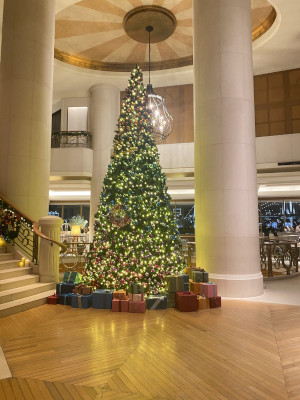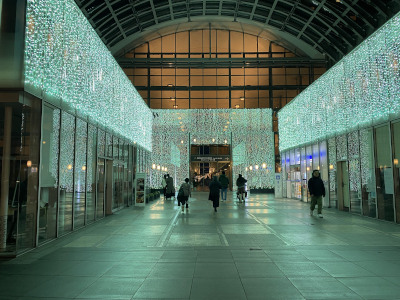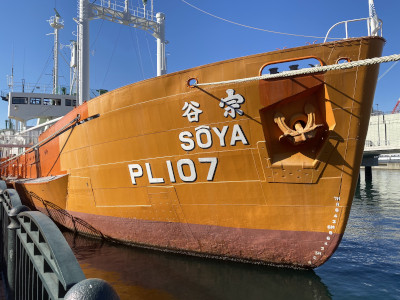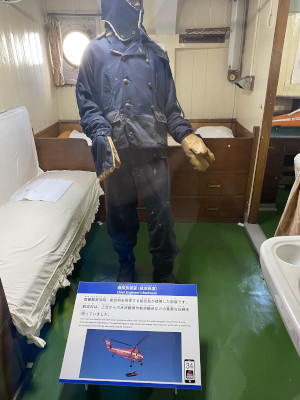Return to Odaiba: fun, food, and a dash of history
January 5, 2025
Introduction
In December 2024, we went on a one-night staycation in Odaiba. Our previous visit two years ago had gone smoothly and left us with fond memories. This time, however, things didn’t go quite as planned.
Day 1
Getting in
We left later than scheduled on a Thursday, and people were already not in the best of moods. The Yurikamome Line, which had been a highlight of our previous trip, didn’t have the same charm this time. Last time, we had waited at Shimbashi to snag the coveted front-row seats with a panoramic view. This time, we boarded an already crowded train. Although we managed to get seats, the view was obstructed by standing passengers, dampening the experience.
After stopping by the hotel to drop off luggage, we headed straight to our first destination, Joypolis.
Joypolis
It was our first time visiting Joypolis, so we weren’t entirely sure what to expect. We had purchased tickets in advance, saving some money compared to buying at the entrance. The passes were the “passport” type, which included unlimited access to most attractions.
Immediately beyond the entrance was the Gekion Live Coaster (撃音ライブコースター), which had an advertised five-minute wait time—a promising start! Not knowing much about the ride, we decided to give it a try. However, after watching it in action and seeing the 360-degree twist, my younger son (8) opted out. My wife took him elsewhere while my older son (10) and I stayed to ride.
The Gekion Live Coaster turned out to be a mix of a rhythm game and a roller coaster. Riders hit buttons in sync with an on-screen animation set to music, with their scores and rankings displayed after each segment. The game segments were interspersed with the roller coaster parts, which were fairly thrilling but brief. The combination of game and ride did not make much sense to me.
After the ride, we regrouped at a small café on the second floor. Thankfully, there was a table available and we could enjoy a quick lunch there, which helped boost morale. Lunch consisted of hot dogs, fried chicken, potato wedges, and churros, which everyone seemed to enjoy.
After lunch, we split up again. My older son was looking to ride a conventional roller coaster without a scoring component and with a short wait time. We did not find anything meeting those requirements. Instead, we ended up lounging at the third-floor café, which overlooked the water.
We soon regrouped with my wife and younger son, who had just finished playing a laser shooting game called Issen (一閃). They seemed to have found it a mixed bag but overall entertaining. The kids then tried their luck at a UFO Catcher machine for a Minecraft doll. Despite not winning, it was a fun experience and boosted the mood a bit.
Before leaving, we gave one last ride a shot: Wild River: The Treasure Hunt (ワイルドリバー ザ・トレジャーハント). This was a simulation ride where the vehicle didn’t move along a track but jolted and swayed while a first-person POV movie played on a large screen. It turned out to be more enjoyable than I had anticipated.
Feeling fairly satisfied, we left the park and headed to the beach.
Beach
By now, it was about 4 PM, just in time for a stunning sunset. The kids had a great time playing by the water, inevitably getting their shoes wet and sandy—a small price to pay for the fun they had.

Hotel
Afterward, we trekked back to the hotel and checked in without any issues. I paid with a stack of JAL coupons, just like last time—a satisfying way to use up some miles. Everyone was exhausted, so we took some time to relax and unwind.
Before dinner, my wife and I checked out the gallery on the third floor. They were hosting an exhibition named Odaiba Wonderful World 6 which seemed to have a fantasy world and anime theme.
Dinner
For dinner, we had reservations next door at the Hilton for a Christmas-themed buffet. I had originally tried to book the Grand Nikko but couldn’t secure a reservation (if I recall correctly, their Garden Dining restaurant was closed for dinner that day). In the end, it worked out well. The dinner was excellent, and the change of scenery was refreshing. The Hilton’s lobby had a large Christmas tree adding to the festive atmosphere and providing a good photo opportunity.

The buffet offered a wide variety of dishes, from appetizers to desserts, with highlights in the main dish section being the roast beef and pork. I didn’t take detailed notes on everything we ate, but it’s safe to say the entire family enjoyed it thoroughly. However, I didn’t really see where the Christmas theme came in.
Walking back to the hotel, we could enjoy some of the Odaiba winter illumination displays.

This concludes Day 1. Despite a few bumps along the way, we ended the day on a high note.
Day 2
We didn’t have a strict plan for Day 2. After enjoying the breakfast buffet, we checked out of the hotel and made our way to Soya.
Soya
Soya (宗谷) is a Japanese icebreaker ship that sailed in the Antarctic until the early 1960s. It now serves as a museum ship. You can simply walk to the ship and board it free of charge.

We arrived a little before noon. A staff member onboard noticed us taking photos at the dock. He kindly called out to let us know that they were about to stop entry for the day due to the end-of-year holiday schedule, so we should board quickly—which we did.
Touring the boat lasted about thirty minutes and was a fascinating glimpse of history. The interior was preserved to look as it did when the ship was active, and seeing the crew’s compact cabins was particularly intriguing. Some of the cabins featured life-sized human figures, which could be a bit startling at first glance.

The story of Taro and Jiro
One famous episode around Soya is the story of Taro and Jiro, two dogs who were found alive a year after being left behind on Antarctica. Most accounts I’ve seen online have left some important question unresolved for me, so I’ve tried to piece the story together here.
In November 1956, Soya departed Tokyo for Antarctica as the first Japanese Antarctic Research Expedition (南極地域観測隊, JARE). On board were 22 Sakhalin Huskies (樺太犬) trained for sledding, including Taro and Jiro, brothers not yet one year old. Upon arrival in Antarctica, eleven crew members and 19 of the dogs settled in Showa Station. Three of the dogs returned home on Soya for reasons such as illness.
The following winter, Soya neared Antarctica carrying the replacement crew, but bad weather prevented it from reaching Showa Station. In February 1958, Soya received assistance from the American icebreaker ship Barton Island to get closer to Showa Station. In six separate air lifts, the original eleven crew members were able to return to Soya. Then three members of the replacement crew also managed to reach Showa Station.
But due to worsening weather, the decision was made to abandon the station, as it was judged that only one more air lift would be possible. The expedition captain ordered the three replacement crew members to return to Soya. As for the dogs, the order was to leave them behind, chained together to prevent them from cannibalizing each other or returning to the wild.
On February 14, the three members returned, bringing back one of the original dogs and her eight puppies, who had been born at Showa Station, aboard the helicopter (as far as I can tell, in some defiance of the order), after some improvised unloading of unnecessary fuel and rations to lighten the load enough to allow for takeoff. However, 15 dogs were left chained near Showa Station, including Taro and Jiro. They were left with enough food for two months. (In case you’re counting carefully and noticed that three dogs are unaccounted for: two dogs had died, and one had gone missing during the winter.)
The plan was for the replacement crew to go to Showa Station once weather permitted. But the weather would not permit another takeoff of the helicopter to Showa Station. The crew was even prepared to drop off arsenic-laced steaks as a last-ditch effort to give the dogs a humane end, but ultimately even that was not possible.
On February 24, the decision from JARE headquarters was made to the abandon the second wintering and Soya was ordered to return home, which it did. The dogs were presumed to have no chance of survival.
The following year, on January 14, 1959, as the third wintering crew arrived, they spotted two Huskies from helicopter. The dog handler of the original expedition, Taiichi Kitamura, who was part of the crew, was quickly dispatched to ascertain their identities. Recognizing their characteristics, he suspected they were Taro and Jiro. The dogs were initially wary of Kitamura, but after Kitamura called out the name “Jiro”, Jiro responded affirmatively by wagging his tail. Likewise, Taro responded to “Taro”.
Incredibly, Taro and Jiro were alive. But sadly, seven of the other dogs had died still chained, and the remaining six were missing. There were no signs of cannibalism.
It is not exactly known how the dogs survived. Interestingly, they did not eat the food left for them. Kitamura has proposed theories such as the dogs feeding on supplies of human food that had been abandoned or a whale carcass, though this doesn’t fully make sense to me considering the seven dogs that died while chained without eating the food left for them, unless these other food sources were reachable while chained.
Many years later, in 1968, the remains of another Sakhalin Husky were found near Showa Station. The dog is believed to be Riki, who was the eldest of the dogs of first expedition and was known to care for and protect the young Taro and Jiro that winter, almost as though he had fathered them. It’s speculated that Riki helped the brothers survive. Unfortunately, Taro and Jiro’s actual father, Furen-no-Kuma, was one of the dogs who was chained and went missing. Their mother, Kuro-no-Ko, was not part of the expedition.
Taro and Jiro continued to serve in Antarctica. Jiro died of illness at Showa Station in 1960. Taro returned to Japan with the fourth wintering team in 1961, and spent the rest of his days at Hokkaido University. He passed away in 1970 of old age.
Military use
The Soya exhibition focuses on the Antarctic expeditions. The ship was also used in wartime. I may have missed more, but I only saw it mentioned in an overall timeline of the ship.
In August 1942, Soya left port to transport troops to the island of Guadalcanal. According to the exhibition, on January 28, 1943, Soya was struck by an American torpedo that failed to detonate, and it reportedly sank an American submarine using depth charges. However, according to the Japanese Wikipedia, while Soya’s escort ship reportedly sank an enemy submarine that day, U.S. military records show no corresponding loss of a submarine.
Walking on the deck of the ship, I reflected on the days it has gone through in war and peace.
Disembarking Soya
After we disembarked from Soya, the friendly staff offered to take our photo in front of the ship. And then we headed to Miraikan, the final stop of the trip.
Miraikan
I wrote about Miraikan on the previous trip. I had initially intended to skip Miraikan after Soya, as I felt the trip was complete and we were getting tired, but the family decided otherwise.

As with last time, we walked up and bought tickets without a reservation, and had no issues. I skipped the Dome Theatre ticket again, since I could not predict our availability at the scheduled movie times. We also had lunch at the Miraikan Kitchen again.
One exhibit that grabbed my attention this time was Nobel Q. Many Nobel laureates have visited Miraikan and were asked to write a question that they wanted visitors to Miraikan to think about. Here are some of the questions that resonated with me:
“How will you improve the world for our children and all who follow behind? We must do everything we can to keep our children’s creativity, critical thinking, curiosity, and empathy. I believe that with a strong foundation, they will lead us forward.” —Barack Obama, Nobel Peace Prize (2009)
“What is your dream? Are you striving towards it?” (あなたの夢はなんですか?夢に向かって頑張っていますか?) —Shinya Yamanaka (山中伸弥), Nobel Prize in Physiology or Medicine (2012)
“Ask yourself: What is it that I want to know?” (私は何が知りたいのか) —Tasuku Honjo (本庶佑), Nobel Prize in Physiology or Medicine (2018)
I also found it fascinating to see the beautiful calligraphic penmanship in some of the Japanese entries.
However, it also seemed that some laureates either misunderstood the task or intentionally deviated from it, as a few of the entries were not framed as questions.
Returning home
After spending a solid amount of time at Miraikan, we headed back home. And with that, our trip came to an end.
Conclusion
This trip received some mixed reactions. The Grand Nikko hotel was lovely again, and the staff went above and beyond to help us during a minor late-night emergency. The dinner at the Hilton was also a highlight. Personally, I also enjoyed Soya. Joypolis was largely a miss; it’s probably more suitable for teenagers and adults than for my family’s age group.
Overall, two overnight trips to Odaiba in three winters feels like enough. Next time, we’ll probably look for a different destination.